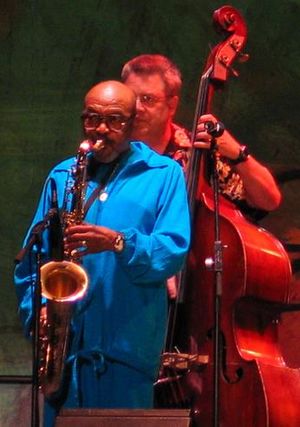James Moody (saxophonist) facts for kids
Quick facts for kids
James Moody
|
|
|---|---|

James Moody with Todd Coolman at a jazz festival
|
|
| Background information | |
| Born | March 26, 1925 Savannah, Georgia, U.S. |
| Died | December 9, 2010 (aged 85) San Diego, California, U.S. |
| Genres | Jazz |
| Occupation(s) | Musician |
| Instruments | Saxophone, flute |
| Years active | 1947–2010 |
| Labels | Novus, Prestige |
| Associated acts | Dizzy Gillespie, Kenny Barron, Jon Faddis, Eddie Jefferson, Johnny Coles, Todd Coolman, Rufus Reid, Gil Fuller, Milt Jackson |
James Moody (born March 26, 1925 – died December 9, 2010) was a famous American jazz musician. He was best known for playing the saxophone and flute. He also sometimes sang. Moody played in the bebop and hard bop styles of jazz.
One of his most famous songs was "Moody's Mood for Love." This song became a surprise hit in 1952. It was based on a solo that Moody played on an earlier recording called "I'm in the Mood for Love." A singer named Eddie Jefferson wrote words to Moody's solo. James Moody loved the song so much that he often sang it himself during his concerts.
Contents
Early Life
James Moody was born in Savannah, Georgia, in the United States. His mother, Ruby Hann Moody Watters, raised him in Newark, New Jersey. He had a brother named Louis. When he was young, he loved the sound of the saxophone. He was inspired by musicians like "Buddy" George Holmes Tate and Don Byas. He also liked the saxophonists who played with Count Basie. Later, he learned to play the flute too.
Career
In 1943, James Moody joined the US Army Air Corps. He played in a band for African-American soldiers at the Greensboro Training Center. After leaving the military in 1946, he started playing bebop music. He played with the famous jazz trumpeter Dizzy Gillespie for two years. Moody also played with Gillespie again in 1964.
In 1948, Moody began his long career of recording music. He recorded for Blue Note Records. That same year, he moved to Europe and stayed there for three years. He said he had faced difficulties because of racism in the U.S. While in Europe, he recorded the first version of "Moody's Mood for Love." This song became a big hit in 1952. His time in Europe helped him become a well-known recording artist.
In 1952, he came back to the U.S. He continued to record music with Prestige Records and other labels. He played both flute and saxophone in bands. In 1955, James Moody and his Orchestra performed at the famous Cavalcade of Jazz concert. This event was held at Wrigley Field in Los Angeles.
In the 1960s, he joined Dizzy Gillespie's band again. He also worked with other musicians like Mike Longo. Later in his career, Moody often played with his own group, the James Moody Quartet. He also performed regularly with the Dizzy Gillespie Alumni All-Stars. He worked with trumpeter Jon Faddis many times. In 1986, Moody toured with the Philip Morris Superband. They visited countries like Australia, Canada, and Japan.
Awards and Honors
James Moody received many awards for his music. Two months after he passed away, he won a Grammy Award. This award was for Best Jazz Instrumental Album for his album Moody 4B.
The New Jersey Performing Arts Center hosts a special event in his honor. It is called the James Moody Democracy of Jazz Festival. In 1998, he was given an NEA Jazz Masters Fellowship. This is a very high honor for jazz musicians. He also helped with educational programs to teach young people about jazz.
Personal Life
James Moody was married three times. His third marriage was to Linda Petersen McGowan in 1989. He had a daughter named Michelle Moody Bagdanove. Through Linda, he also had three step-sons: Regan, Danny, and Patrick McGowan. James and Linda Moody lived in San Diego.
He was a dedicated member of the Baháʼí Faith. In 2005, the Moodys created the Moody Scholarship Fund. This fund helps music students at the Conservatory of Music at Purchase College-State University of New York (SUNY Purchase).
Death
On November 2, 2010, James Moody's wife shared sad news. She announced that he had pancreatic cancer. He decided not to have aggressive treatment for it. James Moody received palliative care to keep him comfortable. He passed away in San Diego on December 9, 2010. His death was due to complications from the cancer.
Discography
James Moody recorded many albums throughout his career. Some of his albums as a leader include:
- 1949: James Moody's Greatest Hits!
- 1952: James Moody and his Modernists
- 1956: Moody's Mood for Love
- 1960: Hey! It's James Moody
- 1995: Moody's Party: Live at the Blue Note
- 2010: Moody 4B
He also played on many albums with other famous jazz musicians, such as Dizzy Gillespie, Art Farmer, and Milt Jackson.
Images for kids
See also
 In Spanish: James Moody para niños
In Spanish: James Moody para niños


